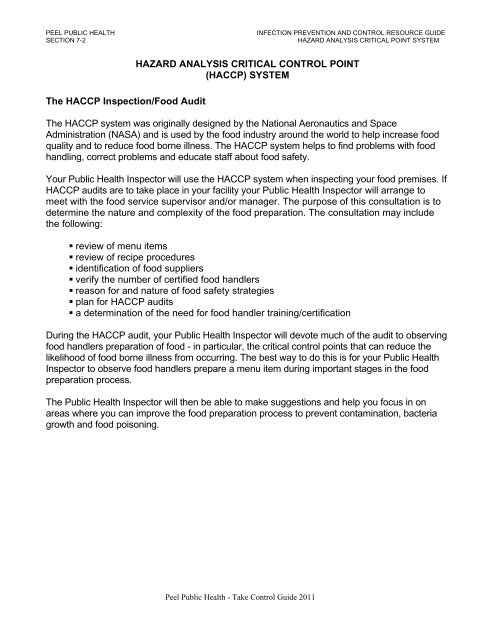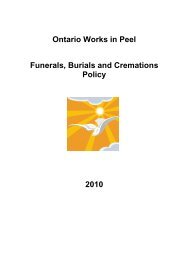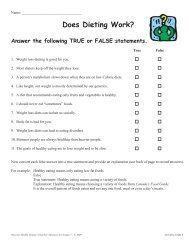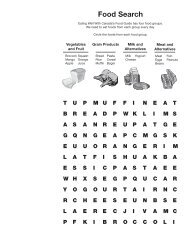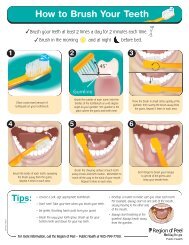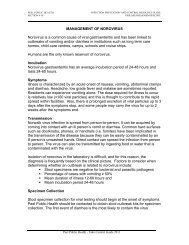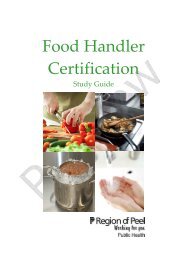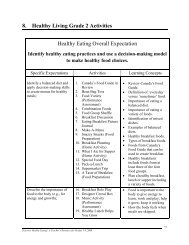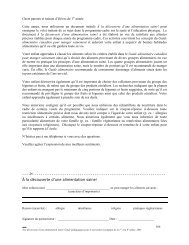Hazard Analysis Critical Control Point System - Region of Peel
Hazard Analysis Critical Control Point System - Region of Peel
Hazard Analysis Critical Control Point System - Region of Peel
You also want an ePaper? Increase the reach of your titles
YUMPU automatically turns print PDFs into web optimized ePapers that Google loves.
PEEL PUBLIC HEALTH<br />
SECTION 7-2<br />
INFECTION PREVENTION AND CONTROL RESOURCE GUIDE<br />
HAZARD ANALYSIS CRITICAL POINT SYSTEM<br />
The HACCP Inspection/Food Audit<br />
HAZARD ANALYSIS CRITICAL CONTROL POINT<br />
(HACCP) SYSTEM<br />
The HACCP system was originally designed by the National Aeronautics and Space<br />
Administration (NASA) and is used by the food industry around the world to help increase food<br />
quality and to reduce food borne illness. The HACCP system helps to find problems with food<br />
handling, correct problems and educate staff about food safety.<br />
Your Public Health Inspector will use the HACCP system when inspecting your food premises. If<br />
HACCP audits are to take place in your facility your Public Health Inspector will arrange to<br />
meet with the food service supervisor and/or manager. The purpose <strong>of</strong> this consultation is to<br />
determine the nature and complexity <strong>of</strong> the food preparation. The consultation may include<br />
the following:<br />
• review <strong>of</strong> menu items<br />
• review <strong>of</strong> recipe procedures<br />
• identification <strong>of</strong> food suppliers<br />
• verify the number <strong>of</strong> certified food handlers<br />
• reason for and nature <strong>of</strong> food safety strategies<br />
• plan for HACCP audits<br />
• a determination <strong>of</strong> the need for food handler training/certification<br />
During the HACCP audit, your Public Health Inspector will devote much <strong>of</strong> the audit to observing<br />
food handlers preparation <strong>of</strong> food - in particular, the critical control points that can reduce the<br />
likelihood <strong>of</strong> food borne illness from occurring. The best way to do this is for your Public Health<br />
Inspector to observe food handlers prepare a menu item during important stages in the food<br />
preparation process.<br />
The Public Health Inspector will then be able to make suggestions and help you focus in on<br />
areas where you can improve the food preparation process to prevent contamination, bacteria<br />
growth and food poisoning.<br />
<strong>Peel</strong> Public Health - Take <strong>Control</strong> Guide 2011
PEEL PUBLIC HEALTH<br />
SECTION 7-2<br />
INFECTION PREVENTION AND CONTROL RESOURCE GUIDE<br />
HAZARD ANALYSIS CRITICAL POINT SYSTEM<br />
Developing your own HACCP Plan<br />
You may wish to develop your own HACCP plan.<br />
The HACCP system is a seven-step system. The seven steps are:<br />
Step 1: Assessing Food Safety <strong>Hazard</strong>s<br />
Step 2: Identifying <strong>Critical</strong> <strong>Control</strong> <strong>Point</strong>s<br />
Step 3: Establishing Standard Operating Procedures<br />
Step 4: Monitoring <strong>Critical</strong> <strong>Control</strong> <strong>Point</strong>s<br />
Step 5: Taking <strong>Control</strong> <strong>Point</strong>s<br />
Step 6: Setting Up an Effective Record-Keeping <strong>System</strong><br />
Step 7: Verifying Your <strong>System</strong> is Working<br />
<strong>Peel</strong> Public Health - Take <strong>Control</strong> Guide 2011
PEEL PUBLIC HEALTH<br />
SECTION 7-2<br />
INFECTION PREVENTION AND CONTROL RESOURCE GUIDE<br />
HAZARD ANALYSIS CRITICAL POINT SYSTEM<br />
The following gives detailed information about each <strong>of</strong> the seven steps.<br />
Step 1: Assessing Food Safety <strong>Hazard</strong>s<br />
The question to ask at this step is:<br />
Where are food safety problems most likely to occur<br />
1. Identify menu items that contain hazardous foods.<br />
<strong>Hazard</strong>ous foods are the foods usually implicated in food borne outbreaks. Examples<br />
include: cooked poultry, beef, veal, pork, ham, fish, other seafood, mixed salads, cooked<br />
rice, egg dishes and pureed foods.<br />
<strong>Hazard</strong>ous ready-to-eat foods are considered to be especially high risk if they have been<br />
mixed, sliced, or blended in the same equipment used for the preparation <strong>of</strong> raw food<br />
products, even if the equipment is adequately cleaned and sanitized between food<br />
preparations.<br />
2. Draw a flow chart for that menu item.<br />
The term flow <strong>of</strong> food refers to the steps food items take as they move through your<br />
facility from receiving to service.<br />
A flow chart is a diagram <strong>of</strong> the food preparation steps for a specific food item from<br />
receiving through to serving. The internal temperature <strong>of</strong> the food, potential points for<br />
cross contamination, methods <strong>of</strong> cleaning and sanitizing, hygiene observations and<br />
duration <strong>of</strong> process could be included in the flow chart.<br />
3. Identify food safety concerns (hazards) that could develop in your recipe ingredients<br />
during each part <strong>of</strong> the flow <strong>of</strong> food.<br />
Potential food hazards can generally be grouped under three categories:<br />
1. lack <strong>of</strong> personal hygiene<br />
2. cross contamination and<br />
3. time/temperature abuse<br />
The identification <strong>of</strong> unsafe food temperatures, unhygienic practices<br />
and situations that could lead to cross contamination such as improper cleaning and<br />
sanitizing <strong>of</strong> food contact surfaces must be corrected.<br />
<strong>Peel</strong> Public Health - Take <strong>Control</strong> Guide 2011
PEEL PUBLIC HEALTH<br />
SECTION 7-2<br />
INFECTION PREVENTION AND CONTROL RESOURCE GUIDE<br />
HAZARD ANALYSIS CRITICAL POINT SYSTEM<br />
Step 2: Identifying <strong>Critical</strong> <strong>Control</strong> <strong>Point</strong>s<br />
<strong>Critical</strong> <strong>Control</strong> <strong>Point</strong>s (CCPs) are those points in food preparation where proper food<br />
handling can reduce or eliminate harmful bacteria or other contaminants.<br />
Important <strong>Critical</strong> <strong>Control</strong> <strong>Point</strong>s (CCP’s) to Monitor with <strong>Hazard</strong>ous Food:<br />
Product Flow CCP’s to Monitor<br />
Source Use pasteurized dairy products<br />
Buy meat and poultry from federally and provincially inspected<br />
establishments<br />
Do not use cracked eggs<br />
Do not use spoiled food<br />
Storage Keep food at 4°C (40°F) or colder<br />
Freeze food to -18°C (0°F) or colder<br />
Separate raw and cooked food<br />
Store cooked food above raw food<br />
Store ready-to-eat food above raw food<br />
Thawing In a refrigerator unit at 4°C (40°F) or colder<br />
Under cold running water, or<br />
In a microwave oven only when the food will be cooked immediately<br />
Food Preparation Do not allow food to remain in the danger zone for more than a total <strong>of</strong> 2<br />
hours<br />
Wash hands frequently, especially after using the washroom, after handling<br />
raw food and before handling ready-to-eat foods<br />
Wash and sanitize all surfaces which food has touched between each use<br />
Internal Food<br />
Cook whole poultry to 82°C (180°F)<br />
Cooking<br />
Cook poultry, poultry products, ground poultry and poultry stuffing to 74°C<br />
Temperature<br />
(165°F) or hotter<br />
Cook pork products to 71°C (160°F)<br />
Cook ground meat to 71°C (160°F)<br />
Cook other hazardous foods to 74°C (165°F) or hotter<br />
Hold for service Hot hold food at 60°C (140°F) or hotter<br />
Internal Food<br />
Cooling<br />
Temperature<br />
Reheating Cooked<br />
Foods<br />
Hold cold food at 4°C (40°F) or colder<br />
Cool cooked food to serve at a later time from 60°C (140°F) to 20°C (68°F) in<br />
2 hours or less<br />
Cool cooked food to serve at a later time from 20°C (68°F) to 4°C (40°F) in 4<br />
hours or less<br />
Reheat cooked foods quickly to original cooking temperature.<br />
<strong>Peel</strong> Public Health - Take <strong>Control</strong> Guide 2011
PEEL PUBLIC HEALTH<br />
SECTION 7-2<br />
INFECTION PREVENTION AND CONTROL RESOURCE GUIDE<br />
HAZARD ANALYSIS CRITICAL POINT SYSTEM<br />
Examples <strong>of</strong> critical control points include:<br />
• final internal cooking temperature<br />
• final internal reheating temperature<br />
• final cooling temperature<br />
• hot and cold holding temperatures<br />
The question to ask at this step is:<br />
Can a food handler control or eliminate the food safety hazard<br />
If you can answer “yes” to this question, then it is a CCP. A CCP must be something you<br />
can measure or observe such as a final food cooking temperature.<br />
CCPs usually involve food cooking time and temperature as well as food handler health and<br />
hygiene, cross-contamination and cleaning and sanitizing.<br />
Step 3: Establishing Standard Operating Procedures<br />
These are your procedures to ensure safe food handling in your facility. Standard operating<br />
procedures should be based on food safety facts and laws and be as specific as possible.<br />
Think <strong>of</strong> SOPs as the requirements that must be met to keep food safe at each step in the flow<br />
<strong>of</strong> food. These are the routine procedures that must be followed throughout food preparation,<br />
similar to routine practices in infection control.<br />
SOPs that can be measured include:<br />
• cooking<br />
• cooling<br />
• reheating<br />
• holding temperatures and<br />
• time<br />
SOPs that can be observed include:<br />
• handwashing<br />
• cleaning and sanitizing <strong>of</strong> equipment and food contact surfaces.<br />
<strong>Peel</strong> Public Health - Take <strong>Control</strong> Guide 2011
PEEL PUBLIC HEALTH<br />
SECTION 7-2<br />
INFECTION PREVENTION AND CONTROL RESOURCE GUIDE<br />
HAZARD ANALYSIS CRITICAL POINT SYSTEM<br />
Step 4: Monitoring <strong>Critical</strong> <strong>Control</strong> <strong>Point</strong>s<br />
Monitoring involves checking to make sure that your CCP standards are being met.<br />
The questions to ask at this step are:<br />
• What food will be monitored<br />
• How will the food be monitored<br />
• Who will monitor the food CCPs<br />
• How <strong>of</strong>ten will the food CCPs be monitored<br />
• What food temperatures, cooking, cooling, reheating and holding times need to be<br />
recorded<br />
• Where and when should CCPs be recorded<br />
For example: monitoring hot holding <strong>of</strong> beef stew<br />
What food: beef stew in the steam table<br />
How to monitor: with a clean and sanitized probe thermometer<br />
Who: chef or prep cook<br />
How <strong>of</strong>ten: every half hour while food is in the steam table<br />
What to record: temperature and time <strong>of</strong> beef stew to be recorded on log sheet<br />
Step 5: Taking Corrective Action<br />
If a CCP standard is not met, corrective action must be taken.<br />
The question to ask at this step is:<br />
What should a food handler do if the critical control point limit or standard operating<br />
procedure is not met<br />
A corrective action must be established for each critical control point and standard operating<br />
procedure.<br />
Examples <strong>of</strong> corrective actions include:<br />
• Rejecting a shipment<br />
• Calling a supervisor or manager for advice<br />
• Cooking food for a longer period <strong>of</strong> time<br />
• Moving or covering the food to prevent cross-contamination<br />
• Discarding the food<br />
<strong>Peel</strong> Public Health - Take <strong>Control</strong> Guide 2011
PEEL PUBLIC HEALTH<br />
SECTION 7-2<br />
INFECTION PREVENTION AND CONTROL RESOURCE GUIDE<br />
HAZARD ANALYSIS CRITICAL POINT SYSTEM<br />
• Food handlers washing their hands at critical times<br />
• Reducing the time the hazardous food is in the temperature danger zone<br />
• Sanitizing work surfaces and utensils at critical stages <strong>of</strong> food preparation<br />
Step 6: Setting Up an Effective Record-Keeping <strong>System</strong><br />
The question to ask at this step is:<br />
What records are needed to show that food is being prepared safely<br />
Records should show that critical control points and standard operating procedures are being<br />
monitored.<br />
Keep written records;<br />
• simple;<br />
• easy to understand;<br />
• easy to use and;<br />
• within reach<br />
Examples <strong>of</strong> what you can do for good record keeping:<br />
Develop a HACCP recipe binder. Include the CCPs, SOPs, required monitoring and temperature<br />
recording as well as corrective actions in the recipe for each menu item.<br />
You may wish to use charts for recording:<br />
• Refrigerator temperatures at specific times<br />
• Final cooking temperatures and time<br />
• Holding or displayed food temperature<br />
and time<br />
• Cooling temperature and time<br />
• Reheating temperature and time<br />
Step 7: Verify the Food Safety <strong>System</strong> is Working<br />
The questions to ask at this step are:<br />
Is the HACCP system working for you<br />
Is it helping to identify, prevent and correct problems with food handling<br />
Is it helping with employee training<br />
Does anything need to be changed<br />
<strong>Peel</strong> Public Health - Take <strong>Control</strong> Guide 2011
PEEL PUBLIC HEALTH<br />
SECTION 7-2<br />
INFECTION PREVENTION AND CONTROL RESOURCE GUIDE<br />
HAZARD ANALYSIS CRITICAL POINT SYSTEM<br />
It may help to review your records, review public health inspection reports and listen to<br />
employee concerns when deciding what needs to be changed.<br />
Reference:<br />
Ministry <strong>of</strong> Health <strong>Hazard</strong> <strong>Analysis</strong> <strong>Critical</strong> <strong>Control</strong> <strong>Point</strong> Protocol, October 2008.<br />
APIC Text <strong>of</strong> Infection <strong>Control</strong> and Epidemiology. APIC 2 nd edition Jan 2005; Vol. II: 58:2,58:9<br />
<strong>Peel</strong> Public Health - Take <strong>Control</strong> Guide 2011


